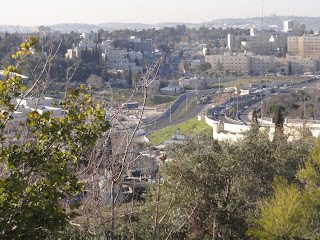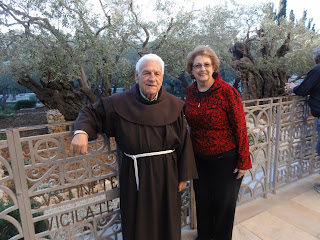Journey toward Jerusalem
As we traveled from Bet She'an south to Jerusalem, we
saw the topography change drastically with the elevation.
We journeyed through the beautiful Jezreel Valley with its lush farmland.
Approximately 95% of the land belongs to the state and is leased by the user. Even when a home is purchased in Israel, the land where the house stands is leased for 99 years. Approval by the state is required to sell a home since the lease needs to pass to the next person.
The hills were incredible and it seemed surreal to see shepherds
guarding their flocks in the same tradition as centuries ago.
We passed through the edge of Samaria and into the Jordan valley.
In the distance, we had a nice view of Jericho, which is now a Palestinian city
located in the West Bank. Jericho has its own source of water from the River Jordan
and is an oasis complete with palm trees in the middle of the desert. During biblical times, Jericho was the first town conquered by Joshua and the Israelites. The people marched around the city for six days, and on the seventh day the city of Jericho fell. It was also in Jericho that Zacchaeus, the chief tax collector, climbed the sycamore tree to see Jesus. (Luke 19:1-10)
We passed the border crossing to Jordan. Next time, I plan on going on into Amman.
As we moved through the Judaean desert,
we saw plenty of sheep looking for food and water.
The landscape was so dramatic with a desolate feeling. On Jesus' last journey from
Jericho to Jerusalem, he took this east-to-west passage steadily ascending the mount
to the Holy City. The route was full of twists and turns. Robbers often hid in the
shadows making the journey hazardous for travelers. Wayside inns and fortresses
were set up along the way - and many remains are still evident today.
This is also the same area where the good Samaritan found an injured man
left to die by robbers and took care of him.
We passed many Bedouin camps which were sprinkled all over the countryside.
Bedouins are semi-nomadic people and make up about 3.5% of the population of Israel.
The government has encouraged them to live in settlements and to settle down in order
to receive education and government services.
The word "Bedouin" means "man of the desert" and the people choose to live
in tented camps or shacks, which is their traditional way of life. Most are sheep herders
or live off the land. They are considered to be the lowest of the socioeconomic scale in
Israel overall. However, many Bedouins are not poor, but still choose to live in the same style.
Our first view of Jerusalem!
Our journey to the Holy City began at 690 feet BELOW sea level in Galilee
and ended at over 3,000 feet ABOVE sea level in Jerusalem.
My ears can definitely tell the difference!
Our first stop was on Mt Scopus at the Hebrew University of Jerusalem to see the spectacular view.
We drove to the Mount of Olives where many denominations have built churches. This is the gold-plated, onion shaped dome of the Russian Church of St. Mary Magdalene. It was constructed in 1885 by the Russian Czar Alexander III to honor his mother Maria and named after Mary Magdalene.
At the foot of the Mount of Olives, just above the Kidron Valley,
stands the garden of Gethsemane, filled with ancient olive trees.
According to the Gospels, Jesus knew Gethsemane well because he often met there with his disciples. Jesus spent his last hours in solitude here, before he was captured by the Romans.
The church of Gethsemane is also called the Church of All Nations. The church bears symbols of the many nations who took part in its construction in 1924. The facade of the church consists of an enormous mosaic, where at the center Jesus prays all alone. Above this are the Greek letters Alpha and Omega from Rev 1:8 - "I am the Alpha and the Omega, says the Lord God..."
On top of the facade are sculptures of two deer which represents Psalms 42:1,
"As a deer pants for streams of water, so my soul pants for you, my God".
Inside the dome of the church, star-like lights are scattered to recreate the somber atmosphere,
reminding us of the deep sorrow Jesus felt when he prayed here.
Prayers inside of the church continue for the faithful.
The Gethsemane Basilica, a small Franciscan church is also located next to the Garden.
One of the monks happily snapped a picture with us. He has been in the
order for over 40 years and came to this area for his last assignment.
The Mount of Olives is one of the most important sites around Jerusalem. It played a central
role in the life of Jesus and he came here often. The name derives from the olive groves that
cover the hill east of the Old City of Jerusalem. The slope of the Mount contains the world's
oldest and largest Jewish cemetery. The peak of the Mount is considered to be the site of
Jesus' ascension into heaven. According to Jewish tradition, this cemetery on the
Mount of Olives is where the resurrection will begin when the Messiah comes.
Orthodox Jews gather at the Mount of Olives for a burial service.
Our first view of the walls and the old Temple Mount (Now the Dome of the Rock)
One of the ancient gates into the walled city of Old Jerusalem.
It's hard to believe that we are actually here!
Tomorrow we go inside of the walls...I can hardly wait!


























Comments
Great story, and you are reviving my memories of when I was in Israel and Jerusalem. Can I give you some additional information I learned when we were at the Mount of Olives and the Golden Gate of Jerusalem? (your last 2 photos.) Christians & Jews alike believe that when the final Resurrection begins, that it will begin at the Mount of Olives, as you say. But there is more to the story. The Messiah (Jesus) will come to Earth at the Mount of Olives, and he will enter the City of Jerusalem thru the Golden Gate (also the gate that faces the rising sun in the east), the same gate in your last photos. Notice how the gate is completely walled from the inside. After the Muslims conquered Jerusalem hundreds of years ago, when they learned Jesus would re-enter the city in the Final Days to claim Jerusalem for his own kingdom, they thought they could prevent him from entering the city by walling up this gate, the traditional gate where Jesus is supposed to enter. This is the only gate of the city they have not allowed to be re-opened because they believe as long as it remains securely shut, they (and Allah) will retain their possession of the city, which is also one of the holiest cities to their own religion. After the gate was permanently walled from the inside, the Christians and Jews decided to foil further gate fortification efforts by the Muslims, so they placed a cemetery on the hill directly outside the gate and that section of wall. Traditionally, Muslims consider cemeteries as unholy places, and if a Muslim walks in a cemetery, they are considered unclean and/or condemned and will be shunned for the rest of their lives. With the placement of the cemetery outside this gate, it assures no Muslims will attempt to fortify the gate or the surrounding walls from the outside. The cemetery looks rather abysmal today from when I was there in 2009.